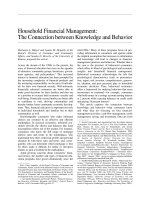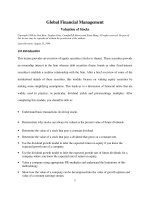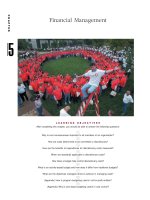Capacity Financial Management
Bạn đang xem bản rút gọn của tài liệu. Xem và tải ngay bản đầy đủ của tài liệu tại đây (224.74 KB, 13 trang )
Strategic Financial Capacity:
Building Financial Capacity for Future Needs
29th Annual Federal, Provincial and Territorial Comptrollers’ Conference
August 17 – 20, 2008
Quebec City
Presented by:
August 20th, 2008
Murray Lindo, Director,
Financial Management & Control Policy,
Office of the Provincial Controller, Ontario Government
1. Environment: Today’s Challenges
Greater public expectations for seamless, quality and value-for-money services.
Focus on results and financial sustainability in health care, education and social services.
Government’s evolving “oversight” role, where increasingly Broader Public Service (BPS)
partners deliver front-line services.
Increased intergovernmental cooperation and collaboration between federal/ provincial/
municipal governments.
Advent of new technologies enabling integrated business and financial solutions.
Elevation of financial management function in supporting programs and leveraging strategic
outcomes.
Realization that financial talent is scare and that the next generation of financial professionals
will have different expectations for their careers and work incentives.
2
2. Purpose
Discuss challenges of recruitment, retention and revitalization in
context of :
key drivers that are shaping government and the financial function;
strategic competencies needs to support this transformation; and
different generations attitudes/ behaviours on the effectiveness strategic
capacity building efforts.
Highlight actions taken by Ontario to respond to these
challenges and to explore opportunities for collaboration with
other jurisdictions
3
3. Key Messages
The value financial professionals bring to the table is in the quality of the
advice we give and trust we build through usable, integrated financial and
non-financial information.
An effective “people-centered” capacity-building strategy depends on us
recognizing how our work is changing, the new skills needed to perform it
and the differing generational profiles (and expectations) which will make up
our financial teams.
4
4. Change Management Challenges
Financial management being the responsibility
of finance function.
Financial management being the responsibility of line
managers, supported by an expert finance function.
Disbursed finance-related units focused
primarily on administering financial processes
and managing business transactions.
Integrated finance function focused on providing
strategic financial expertise to help managers make the
best financial decisions and achieve high value-formoney for services delivered.
Fiscal planning focused primarily on
incremental annual ministry program
expenditures.
Integrated capital, operating and financial planning
focused on managing public sector risks and results
within a robust, risk-based multi-year business plan.
Capacity and information systems focused
primarily on addressing immediate issues and
supporting processes.
Capacity and information systems integrated to provide
strategic financial information, expertise and
management advice.
Diverse understanding of responsibilities,
accountabilities and competencies.
A well defined finance function with clear
responsibilities, accountabilities and performance
expectations working together to support line managers
in achieving the government’s public policy objectives.
Generation: Baby Boomers
Generation: “X” 28 – 43 years old /Gen.“Y” 8 – 27
years old.
5
5. Role of the Finance Function
Management Decision Support
Financial evaluation expertise
Business risk management expertise
Capital investment analysis expertise
Financial performance management expertise
Business Planning, Fiscal Planning and
Budgeting
Strategic business planning expertise
Risk-based Fiscal planning expertise
Capital planning expertise
Integrated capital, operating and cash-flow
budgeting expertise
In-year fiscal management expertise
Accounting, Appropriations and Financial
Reporting
Accounting policy application and control
expertise
Appropriation compliance and control expertise
Costing and pricing expertise
Financial reporting expertise
Financial information analysis and integrity
assurance expertise
Risk Management, Accountability and Control
Program risk management and control expertise
Project risk management and control expertise
Business process risk management and control
expertise.
Asset and liability risk management and control
expertise
Transfer Payment, Agency and Trust risk
management and control expertise.
6
6. Financial Competencies needed
Competencies
Business Knowledge
Effective Costing, Planning & Evaluation
Risk Management
Standards Compliance
Effective Communication
Valued-added
Advice
Strategic
Focus
ValueforMoney
Performance Management
Forecasting, Planning and Budgeting
Accounting/ Financial Knowledge
7
7. Generation Dynamics
Attitudes/
Behaviours
Baby Boomers
(44-62 years)
Gen. “X”
(28-43 years)
Authority
Challenge Authority
“Let me show you what I
can do for you”.
Unimpressed by authority
“Tell me what you can do
for me”.
Respect authority that
demonstrates competence
“Show me what you can
do for me right now”
Change = Caution
Challenges the Rules
Change = Opportunity
Change the Rules
Change = Improvement
Create the Rules
Technical Expert
Creative/ Adaptive
Diverse/ Contribution
Career = Self worth
Job stability
Career = one part of me
Nomadic career
Career = opportunity to
add value
Multiple avenues
Informal/ “On Demand”
Self-reliant/ Techno
savvy/ “bite sized”
Change
Recognition
Career
Learning Style Formal
Gen. “Y”
(8-27 years)
8
8. Capacity Development Design Considerations
Generation
Baby
BabyBoomers
Boomers
(44-62
(44-62years)
years)
Gen.
Gen.“X”
“X”
(28-43
(28-43years)
years)
Gen.
Gen.“Y”
“Y”
(8-27
years)
(8-27 years)
Attraction
Opportunity
Opportunitytoto
“give
“giveback”
back”
Provide
expertise
Provide expertise
Recruitment
Second
SecondCareer
Career
Greater responsibility
Greater responsibility
Retention
Structured
Structuredlearning
learning
Career
pathways
Career pathways
Gateway
Gatewaytoto
multiple
multiple
opportunities
opportunities
Qualitative
Qualitative
Aspect
AspectofofJob
Job
“Job
Hop”
vs.
Career
“Job Hop” vs. Career
Ladder
Ladder
Work/Life
Work/LifeBalance
Balance
Variety
Variety
Mentorship
Mentorship
Personalized
PersonalizedLearning
Learning
Contribute
Contributeby
byusing
using
technotechno-skills
skills
Projects
Projectsover
overProcess
Process
Skills
SkillsDevelopment
Development
“Window”
“Window”
Build
Buildexperience
experience
(Short tenureship)
(Short tenureship)
Horizontal
HorizontalProjects
Projects
WikipediaWikipediaType Learning
Type Learning
9
9. Looking Forward: Elements of a Strategy
Cultural Change:
Raise managers' “financial literacy” through mandatory training and the progressive
transfer of financial accountability.
Finance Function:
Transform finance into an key strategic partner in the achievement of results
Develop/train/recruit more senior finance leaders
Competencies:
Clarify the financial skills/ competencies we need and “raise the bar” on professional
requirements in finance teams
Generational Dynamics:
Recruit more trainees (including fast stream) recognizing different incentives
Help more mature colleagues or potential leaders to qualify
Enhance multi-track career development in government finance
Bridging skilled foreign trained professionals’ “experience” gaps
10
10. Ontario’s Response:
The Office of the Provincial Controller (OPC) is charged with
responsibility for building financial management capacity across
the Ontario Public Service.
OPC’s Actions to date:
Established dedicated Controllership Resource Development (CRD) unit
to develop financial “literacy” training programs
Established a dedicated financial intern program for all OPS ministries
Lead the development of technical/behavioural competencies for key
financial management positions (financial analyst through to senior
management positions)
Developing program to attract foreign-trained financial professionals
Investigating training-office opportunities with accounting associations
Establishing financial community centres of expertise.
11
11. Roundtable Discussion
Are there opportunities for jurisdictions to collaborate on capacity building activities?
Technical knowledge centres to address common issues (e.g., P3s/AFP project accounting
and investment analysis)
Public service-based financial/controllership forum web sites.
Would it make sense to approach the accounting associations to develop a national
training office standard for the public service?
Are there collaboration opportunities with colleges and universities to deliver public
service-focused financial training programs?
What opportunities could be created to improve recruitment and development of
financial specialists?
Establish inter-jurisdictional recruitment programs, promoting public service positions
through university job fairs, use of accounting association recruitment tools, etc.
Examine opportunities to increase number of inter-jurisdictional secondments for financial
specialists.
12
Questions









